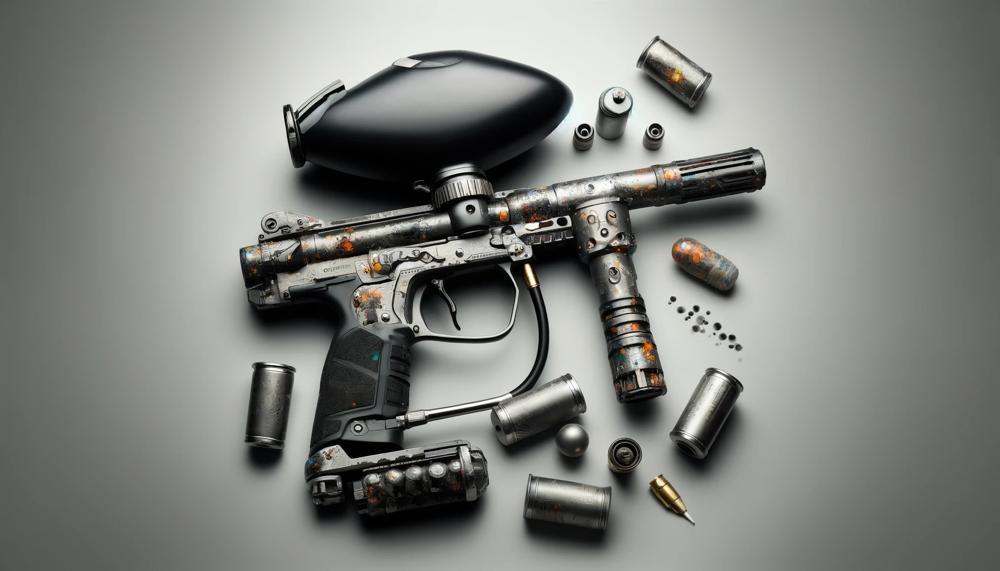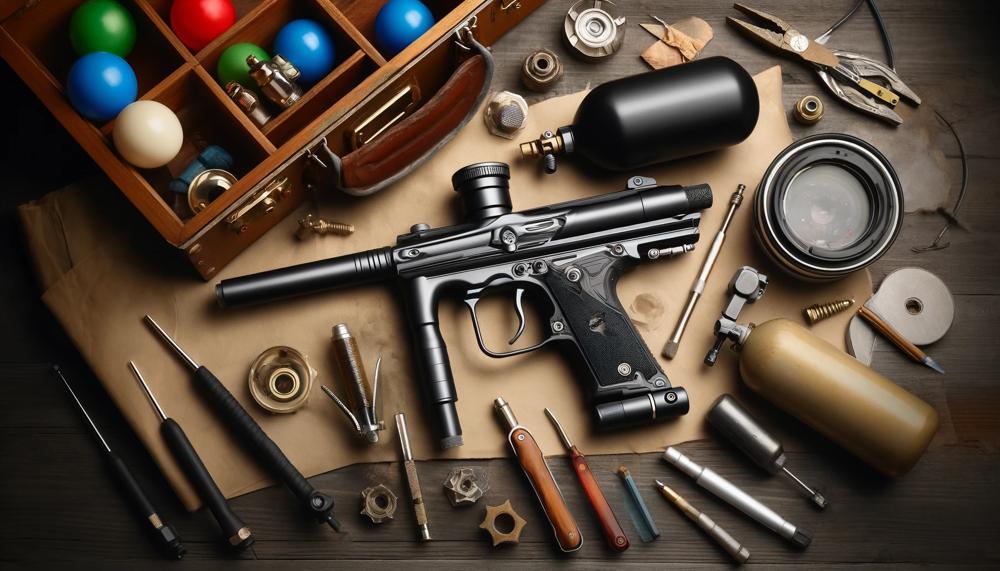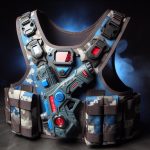Are you tired of constantly lugging around heavy CO2 or compressed air tanks when playing paintball? Do you dread the long lines at the refill station and the expensive tank refills? Well, what if we told you that it’s possible to shoot a paintball without the need for those pesky tanks? Yes, you read that correctly. No more worrying about running out of air mid-game or being tethered to a refill station.
So, Can You Shoot a Paintball Without CO2 or Compressed Air?
No, you cannot shoot a paintball without CO2 or compressed air. Whether the marker used is mechanically or electro-pneumatically operated, it will use propellant to propel the paintball out of the barrel.
The propellant used to power the paintball out of the barrel is a compressed gas. It can take the form of carbon dioxide (CO2), high-pressure air, nitrogen, and even propane1. Regardless of the gas used, it is stored in a pressurized container and released into the expansion chamber as part of the firing process. A paintball marker without a compressed gas to create the expansive wave will not be able to expel a paintball.
The firing process of a paintball marker involves a paintball being pushed or guided into the barrel. At the same time, the ball is sealed in the barrel. A valve releases compressed gas into the barrel at this point, creating the expansion that forces the ball out.
There are different types of paintball markers, and most of their differences reside in how they accomplish the individual steps of the firing process. However, the basic mechanics of the firing process remain the same. For example, mechanical paintball guns rely on a spring and bolt mechanism that is activated when the trigger is pulled.
The bolt is moved forward and pushes an individual paintball into the barrel. The bolt then strikes a pin. This action causes the valve to open, which in turn allows the air to enter the barrel. The bolt then returns to its original position by the same force of expanding air that propels the paintball out of the barrel.
Let’s dive in.
Table of Contents
What Is CO2?
CO2, also known as carbon dioxide, is a crucial component in the process of shooting a paintball from a gun. It is a compressed gas stored in tanks and used as a power source for paintball guns.
When the liquid CO2 expands into gas form, it creates pressure, which propels the paintball out of the gun.
| Role | Explanation |
| Power Source | CO2 serves as a power source for paintball guns due to its density and ability to create pressure when released. |
| Reliability | When compared to other options like HPA systems, CO2 is a reliable and low-maintenance fuel option for paintball guns. |
| Cost-effectiveness | Using CO2 tanks for refilling paintball gun tanks proves to be a cost-effective option. |
| Compatibility | The type of paintball gun will determine which fuel source can be used. While electronic and mechanical markers can use compressed air, plastic markers require CO2. |
| Safety Concerns | It is important to note that using CO2 on an electronic marker can cause damage, making compressed air the preferred option for safety reasons. |
| Performance and Accuracy | When it comes to performance and accuracy, compressed air offers better results compared to CO2. |
| Propane Alternative | In the past, propane was considered as a fuel option but has since been discontinued due to safety concerns. |
| Conversion Possibility | A CO2 paintball gun can be converted into an airsoft gun by using a remote setup and connecting it to an air compressor. |
| Risk of Explosion | Filling a CO2 tank with compressed air should only be done by experts, as it can cause explosions and result in injuries. |
To summarize, CO2 plays a crucial role in shooting paintballs from a gun. It serves as a reliable, cost-effective, and compatible power source for paintball guns.
Types Of CO2 Tanks
There are two main types of CO2 tanks: aluminum and carbon fiber in paintball guns. These tanks have different materials, capacities, weights, and filling methods.
| CO2 Tank Type | Material | Capacity | Weight | Filling Method |
| Aluminum Tank | Made from aluminum | Sizes range from 9oz to 20oz | Lightweight, but heavier than carbon fiber tanks | Can be filled directly or with a fill station/refill at a paintball shop |
| Carbon Fiber Tank | Constructed with a layer of carbon fiber wrapped around an aluminum or fiberglass inner tank | Come in various sizes, such as 68ci or 88ci | Lightweight and smaller than aluminum tanks | Can only be filled with a fill station/refill at a paintball shop |
The type of CO2 tank used can significantly impact the performance of a paintball gun in multiple ways.
- Capacity: Carbon fiber tanks usually have a larger capacity compared to aluminum tanks, allowing for more shots before needing to be refilled. This can be advantageous for players who enjoy longer gameplay sessions.
- Weight: Carbon fiber tanks are lighter than aluminum tanks, making them easier to carry and maneuver during gameplay. However, some players may prefer the added weight of an aluminum tank for stability and balance.
- Filling method: The filling method of the tank can also affect performance. Carbon fiber tanks can only be filled with a fill station or at a paintball shop, while aluminum tanks can be filled directly or with a fill station. Refilling at a shop may be less convenient, but it also ensures that the tank is filled correctly and safely.
- Duration: The duration of the tank depends on factors such as capacity, shooting style, and temperature. Carbon fiber tanks may last longer due to their larger capacity, but aluminum tanks can offer faster shooting speeds in colder temperatures.
What Is Compressed Air (or HPA)?
The main difference between CO2 and compressed air lies in the type of gas used. Carbon dioxide (CO2) is a gas that expands when heated and is commonly used for its ability to propel paintballs. On the other hand, compressed air, also known as high-pressure air (HPA), is a combination of nitrogen and oxygen that is stored at a much higher pressure than CO2.
Consistency and Accuracy:
One of the key differences between CO2 and compressed air is their consistency and accuracy. Compressed air offers a more consistent and accurate shot due to its stable pressure release.
In contrast, CO2 is known for its inconsistency as its expansion and contraction with temperature changes can result in varying velocities, affecting shot accuracy.
Power versus Consistency:
Another factor to consider is the trade-off between power and consistency. CO2 tanks are known for providing a more powerful shot due to the density of the gas, resulting in higher velocities.
However, this power comes at the cost of consistency, as mentioned before. Compressed air tanks may not offer the same level of power but provide a more dependable and consistent shot.
Temperature Sensitivity:
CO2 tanks are also more sensitive to temperature changes compared to compressed air tanks. As mentioned earlier, CO2 expands and contracts with temperature changes, which can significantly impact the performance of the paintball gun.
In contrast, compressed air is not as affected by temperature changes, making it a more reliable choice for cold weather gameplay.
Filling Methods:
Another notable difference is the filling method for both types of tanks. CO2 tanks are typically filled with liquid CO2, while compressed air tanks require specialized equipment to be filled with compressed air.
Most paintball fields charge for all-day compressed air fills, while CO2 refills may be included in admission fees.
Types Of Compressed Air Tanks
When it comes to paintball, choosing the right type of compressed air tank is crucial for optimal performance and safety. There are different types of tanks available, each with its own unique advantages and disadvantages. Let’s take a closer look at the various options and what makes them stand out.
Aluminum HPA tanks are a popular choice due to their ability to hold up to 3000 PSI and provide consistent pressure, making them ideal for electronic markers. However, they do come at a higher cost compared to CO2 tanks.
Fiber wrapped HPA tanks offer added insulation and can hold up to 4500 PSI, providing even higher performance and consistency compared to aluminum tanks. This makes them a top choice for serious paintball players, but they do come with a higher price tag.
On the other hand, CO2 tanks are cheaper and more widely available than HPA tanks. However, they are not as consistent or reliable in terms of performance. Additionally, using CO2 in electronic markers can cause damage if not handled correctly.

Which Is Best?
There are two main options for powering your marker: CO2 and compressed air. Both have their advantages and disadvantages, but many players and experts lean towards compressed air as the best choice for paintball.
In terms of consistency and reliability, compressed air is the clear winner. Unlike CO2, which can be affected by temperature changes and cause fluctuations in pressure and inconsistent shots, compressed air maintains a more stable pressure throughout use. This makes for more reliable shots and reduces the risk of marker malfunctions.
Another factor to consider is ease of use, where compressed air also has the upper hand. It works well in all weather conditions and firing rates, making it a versatile option for any type of game or player. On the other hand, CO2 may struggle in colder weather and with rapid firing, affecting performance.
When it comes to compatibility, compressed air tanks can be used with any marker, while CO2 tanks may only work with certain ones. This means if you switch markers or upgrade to a more advanced one, you won’t have to purchase a new tank if you use compressed air.
While CO2 tanks may seem like a more affordable option upfront, they have more drawbacks in terms of performance and durability. They have a limited lifespan and need to be replaced more frequently than compressed air tanks. They are also more prone to leaks and malfunctions.
So, while CO2 may initially seem like the cheaper and more convenient choice, the reliability, compatibility, and durability of compressed air make it the best option for shooting paintballs.
Conclusion
Finally, carrying big CO2 or compressed air tanks around all the time for paintball can be tiring and cost a lot.
Fortunately, there exists a revolutionary method that eliminates the need for these heavy tanks entirely. By saying goodbye to pricey tank refills and hello to lower costs, players can gain more freedom and movement on the field, not having to worry about running out of air in the middle of a game or being stuck at a refill station.
This option is more stable and accurate than CO2 and is better for the environment. It is the best choice for serious paintball players. This might make CO2 seem like a cheaper choice at first, but it doesn’t work as well or last as long as compressed air.






